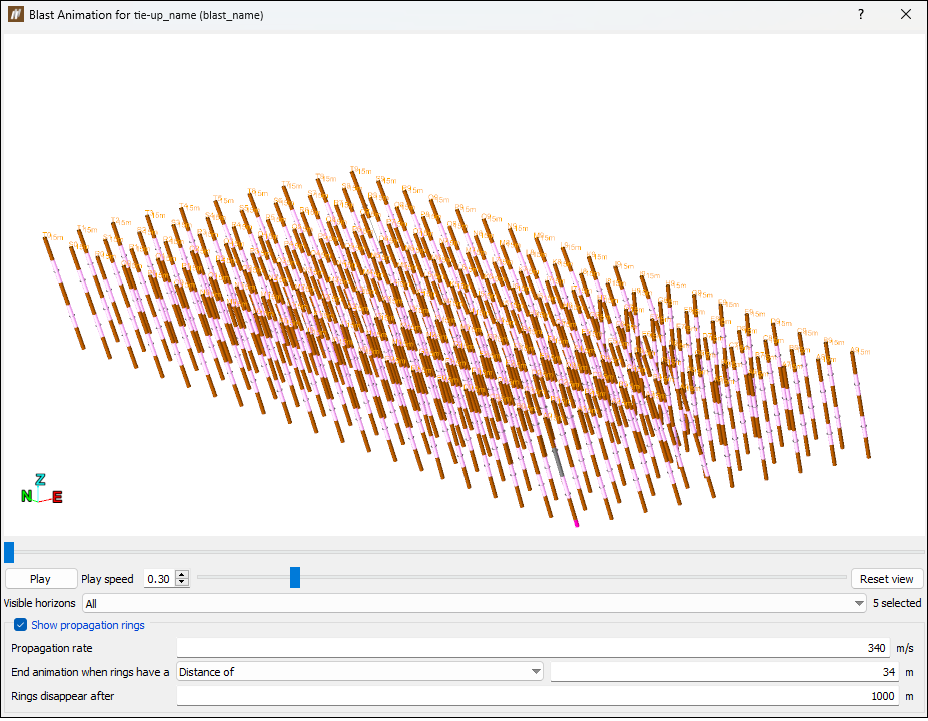Timing
Source file: timing.htm
The Timing group of the Analysis ribbon contains tools that calculate and display different detonation timing properties of a tie-up.

 Timing Envelope
Timing Envelope
The timing envelope displays a graph depicting the following detonation properties over time (ms):
- Detonation count
- Hole count
- Detonation mass (kg)
- Detonation energy (MJ)
- Peak particle velocity (mm/s)
- Max pressure (dB)
These values are determined over a user-specified timing window (usually 8 ms).
To use this tool, follow these steps:
-
Place the required tie-up into the view window.
-
Go to the Analysis ribbon > Timing group and select
 Timing Envelope.
Timing Envelope.Note: This option is also accessible from the context menu of the tie-up design. To enter it, right-click on the tie-up in the

Tie-upscontainer and select Model > Timing Envelope....
Timing Envelope....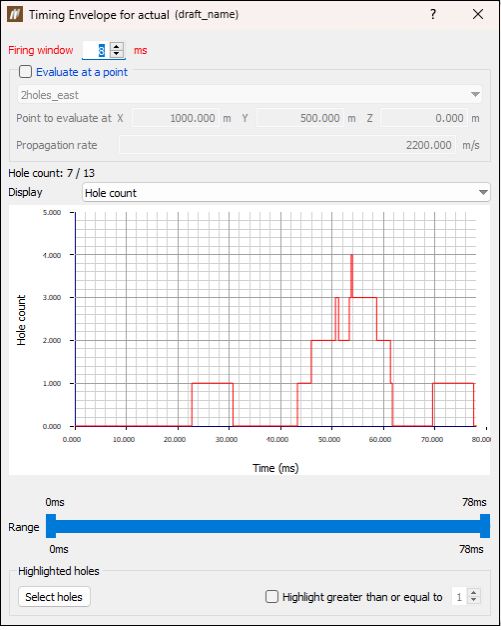
You can evaluate the timing envelope at a point by selecting the Evaluate at a point checkbox. This is either calculated at a site location from the drop-down menu or at a custom point when you select Custom location... from the drop-down menu. This feature calculates the timing envelope from the blast to the specified point with the specified propagation rate. If unchecked, the tool will evaluate the timing envelope at the blast (assuming there is no propagation rate).
You can zoom the graph by adjusting the Range slider at the bottom of the panel. The values displayed above the slider are the minimum and maximum values that can be set for that range, whereas the values displayed below the slider show the currently set range. Using the Display drop-down, you can set the Y axis to display Hole count, Detonation count, Detonation mass (kg), Detonation energy (MJ), Peak particle velocity (mm/s), or Max pressure (dB).
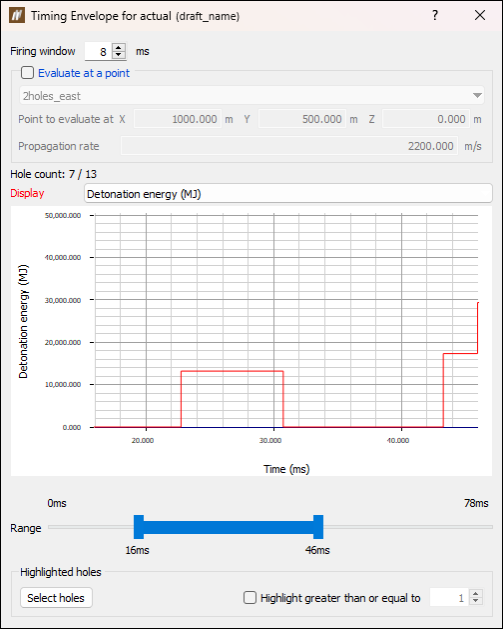
You can highlight specific groups of holes in the view window by selecting the Highlight greater than or equal to checkbox and entering a value. This is useful for easily locating holes and adjusting the tie-up around them to correct the timing envelope.
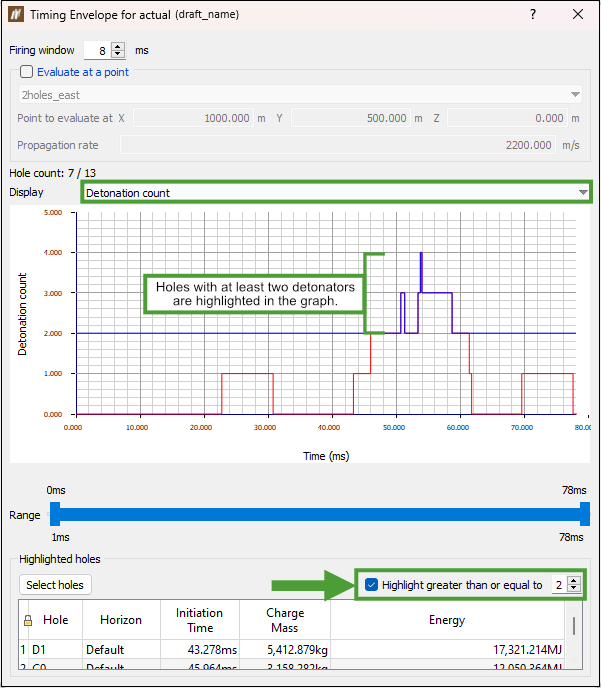
In your view, you can also highlight individual peaks on the graph by double-clicking on them. This can help you determine which holes correspond to the specific peaks of the maximum instantaneous charge when there are multiple peaks with the same charge mass.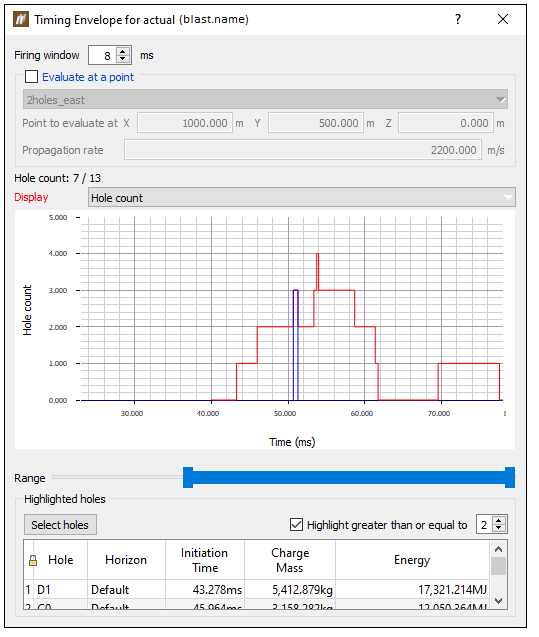
Estimating maximum instantaneous charge (MIC)
The timing envelope histogram can be quickly used to estimate MIC for a specified firing window.
-
Specify the desired Firing window.
Note: Typically 8 ms is used to estimate MIC for non-electronic tie-ups, and 1 or 2 ms is used for electronic tie-ups.
-
Select Detonation Mass as the display option.
-
Hover the mouse over the highest column in the histogram to display the mass value (the MIC for the blast).
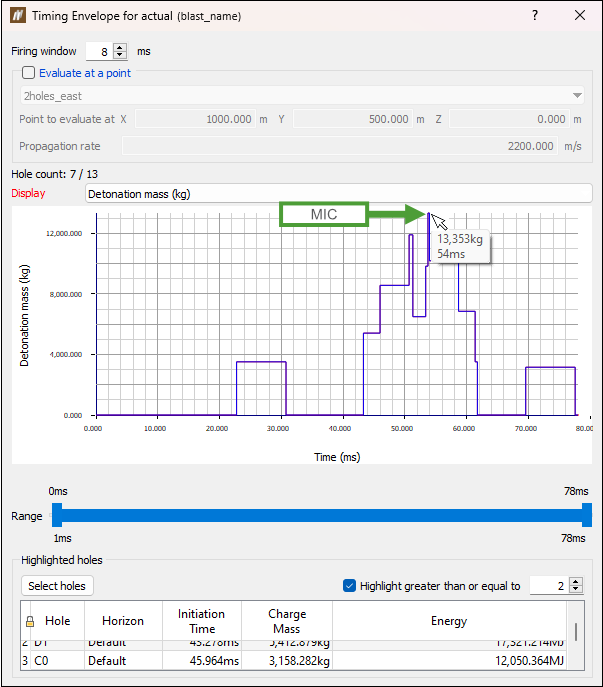
Peak particle velocity
A particle velocity graph can be calculated for a specified firing window using the following steps:
-
Specify the desired Firing window.
-
Select Evaluate at a point and choose a location close to the blast(s).
-
Select Peak particle velocity as the display option.
-
For custom locations or locations with no default values, enter the Vibration variable and Vibration exponent.
-
Hover the mouse over the highest column in the histogram to display the Peak Particle Velocity value. This should match the value calculated using Vibration Modelling.
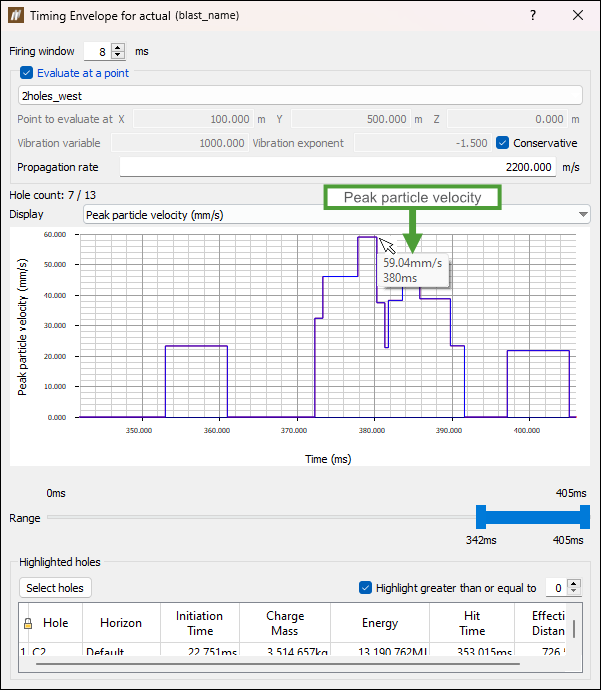
 Timing Contour
Timing Contour
Use timing contours to visualise the timing between nearby holes to identify patterns and infer the direction of rock movement.
Follow these steps to create a timing contour:
-
Place the required tie-up into the view window.
-
Go to Analysis ribbon > Timing group and select
 Timing Contour.
Timing Contour.Note: This option is also accessible from the context menu of the tie-up design. To enter it, right-click on the tie-up in the

Tie-upscontainer and select Model > Timing Contour....
Timing Contour.... -
Adjust your view by selecting Detonation position (Collar, Earliest primer, or Toe). You can set the interval for the major contours by entering the new value in Major Interval field or using the range slider.
-
For an electronic tie-up with multiple timing horizons, choose the Horizon to view. Each timing horizon has different initiation times.
A pyrotechnic tie-up will show the surface initiation timing curves.
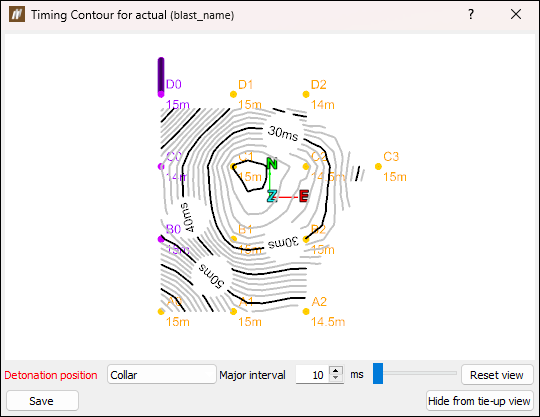
-
Press Save to create a new object in the cad container. The object will contain the lines and labels that make up the timing contour.
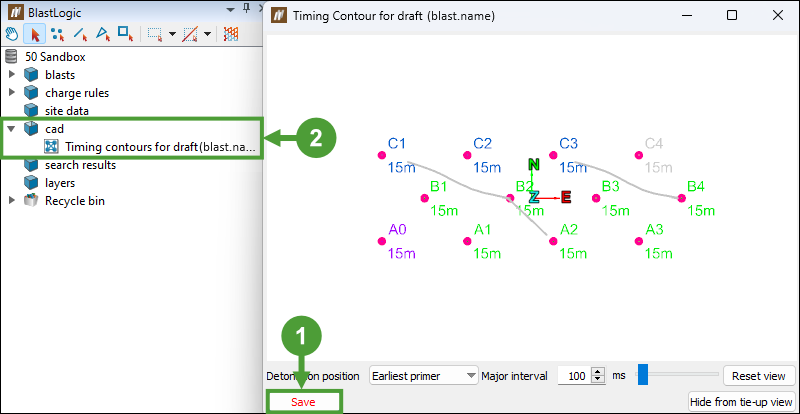
-
Press Hide/Show from tie-up view to remove or add the timing contour from the view that contains the tie-up that the timing contour is based on.
 Burden Relief Surface
Burden Relief Surface
Burden relief is the amount of detonation time delay per metre of burden at a given location. It is calculated by dividing the time taken to detonate a hole by the hole's distance (in metres) from the free face, which is the area where material is transferred to upon explosion.
To create a burden relief surface:
-
Place the required tie-up design into the view window.
-
Go to Analysis ribbon > Timing group and select
 Burden Relief Surface.
Burden Relief Surface.Note: This option is also accessible from the context menu of the tie-up design. To enter it, right-click on the tie-up in the

Tie-upscontainer and select Model > Burden Relief Surface... .
Burden Relief Surface... . -
For an electronic tie-up with multiple timing horizons, choose the Horizon to view. Each timing horizon has a different burden relief surface.
The surface is displayed alongside the blast with colours according to the legend.
The burden relief can be evaluated at a point by first clicking in the X field, and then clicking on a point in the surface. -
You can load a previously created custom colour scheme by clicking the Load colour scheme... button. This will allow you to load a colour scheme that you have saved in the Custom colour schemes panel (Home ribbon > Setup group >
 Site).
Site).Important: Only colour schemes that have their Dimension specified as Inverse velocity can be loaded.
See Load for more information.
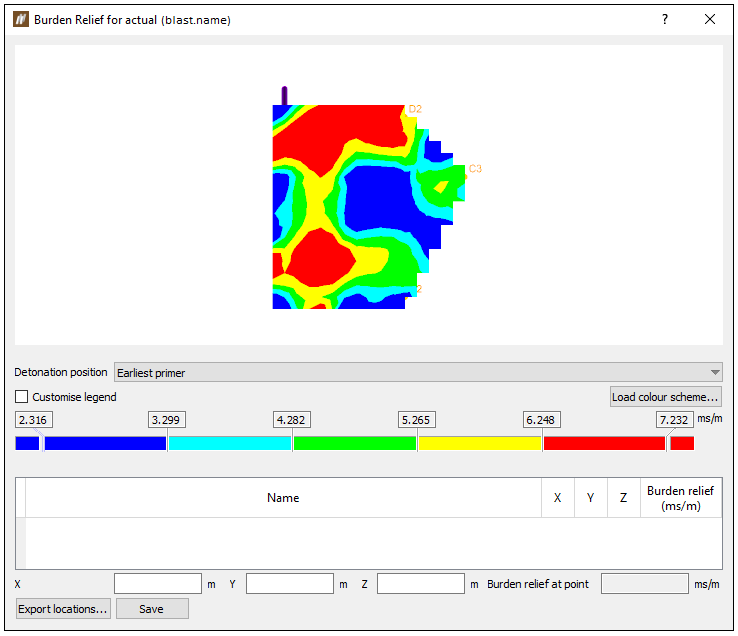
- To edit the colour scheme, click the Customise legend checkbox . You will be able to edit intervals and colours. To save the colour scheme, right-click on the set colour scheme and select Copy, and then create a new colour scheme in the Custom Colour Schemes panel (Home ribbon > Setup group>
 Site) by specifying its name and pasting the copied colour scheme by right-clicking on the colour bar below the table.
Site) by specifying its name and pasting the copied colour scheme by right-clicking on the colour bar below the table.
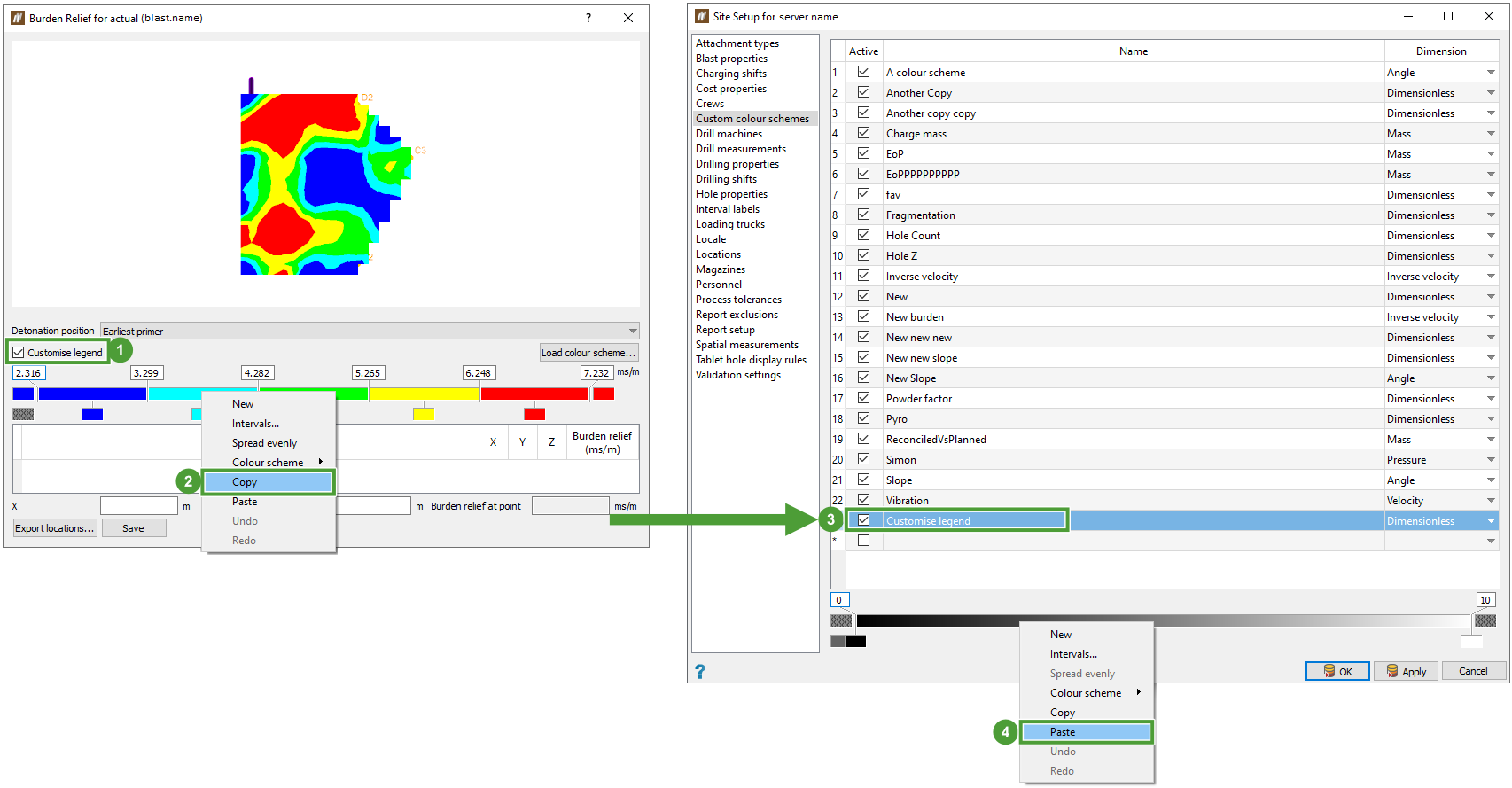
 First Movement Diagram
First Movement Diagram
The First Movement Diagram displays the direction that the rock is expected to move after detonation at each point.
To use this tool:
-
Place the required tie-up design into the view window.
-
Go to Analysis ribbon > Timing group and select
 First Movement Diagram.
First Movement Diagram. Note: This option is also accessible from the context menu of the tie-up design. To enter it, right-click on the tie-up in the

Tie-upscontainer and select Model > First Movement Diagram....
First Movement Diagram.... 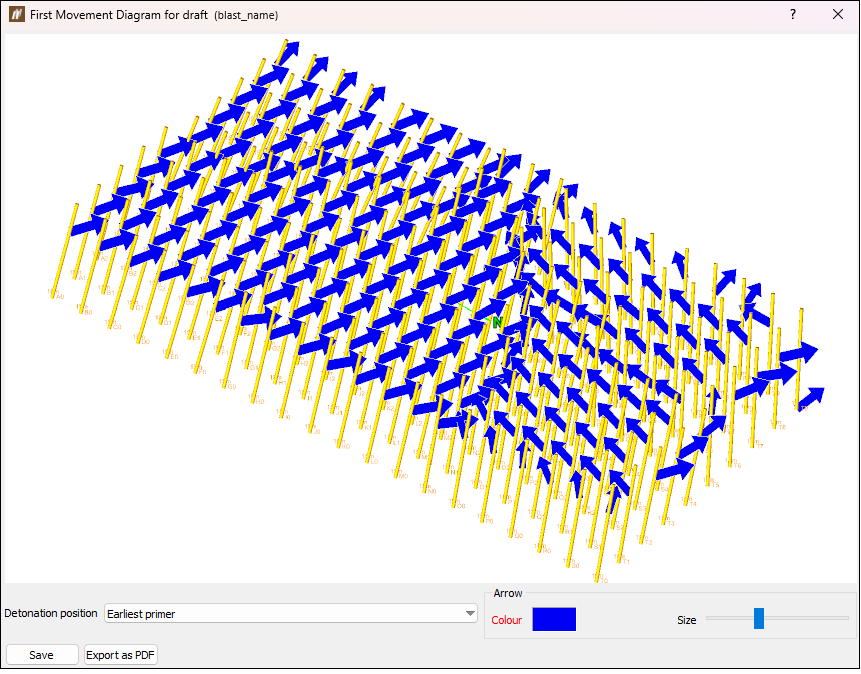
-
For an electronic tie-up with multiple timing horizons, choose the Horizon to view. Each timing horizon will have different firing times.
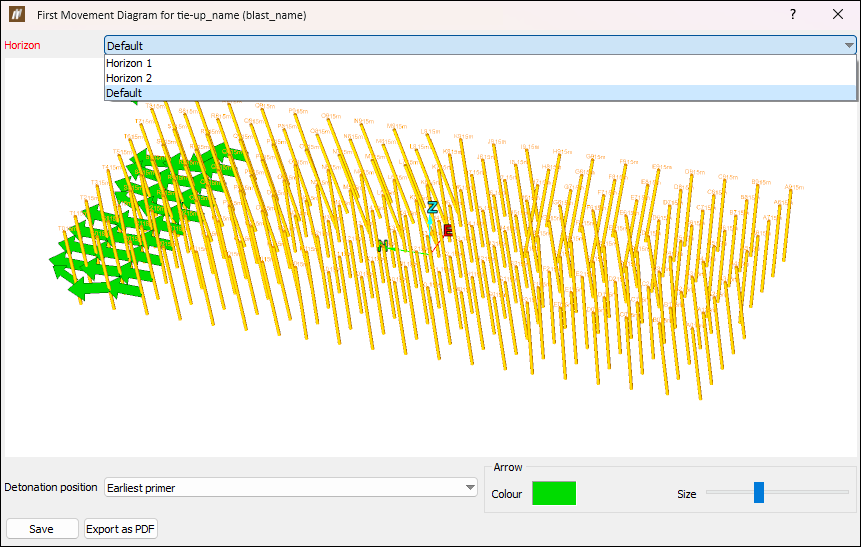
-
Specify the Detonation position by selecting Collar, Earliest primer, or Toe from the drop-down.
Collar 
Earliest primer 
Toe 
-
To change the colour of the arrows in your view, click the Colour box field and select the colour from the colour grid.
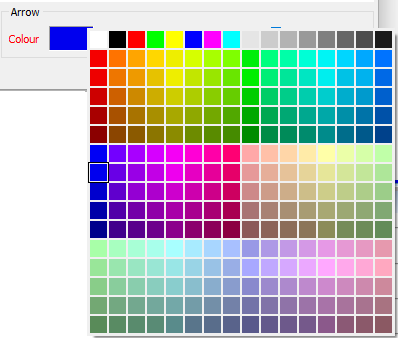 Tip
TipDouble-click the Colour box field to open Select a colour window with detailed colour settings.
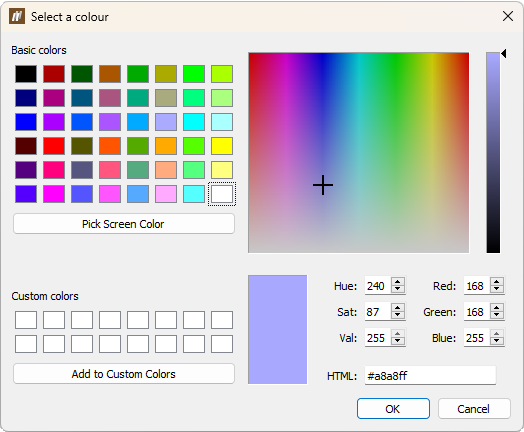
-
Move the slider next to the Size heading to adjust the size of arrows in your view.
-
Select Save to save the applied changes. The first movement diagram will be saved in the

site datacontainer in project explorer.
-
Select Export as PDF to generate a ready to save and print First Movement Diagram file.
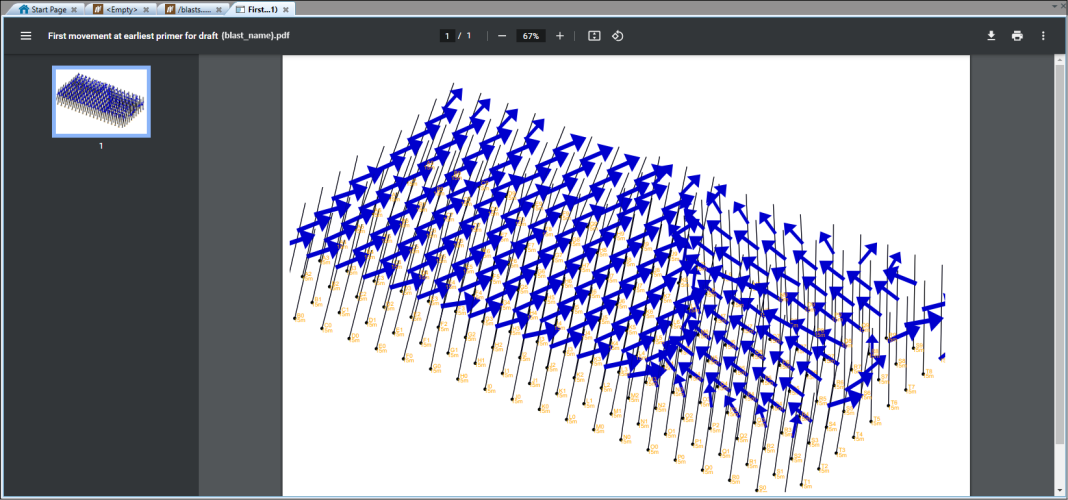
 Animate Tie-up
Animate Tie-up
The Animate Tie-up tool visually displays the selected tie-up design's detonation sequence.
To use the tool:
-
Place the required tie-up design into the view window.
-
Go to Analysis ribbon > Timing group and select
 Animate Tie-up.
Animate Tie-up. Note: This option is also accessible from the context menu of the tie-up design. To enter it, right-click on the tie-up in the

Tie-upscontainer and select Model > Animate Tie-up....
Animate Tie-up.... -
Customise your tie-up animation by setting the Play speed and Visible horizons.
-
Optionally, select the Show propagation rings checkbox to display the propagation rings visualise the detonation shockwave through the blast. Set the following fields:
-
Propagation rate, by entering the value in m/s unit.
-
End animation when rings have a, by setting an appropriate value and selecting one of the options from the drop-down menu:
-
Time after last detonation of
-
Time after initiation of
-
Distance of
-
-
Rings disappear after, by entering the distance.
-
-
Play or pause the animation with the Play/Pause button. You can use the slider to manually view individual frames of the animation.
Animation when Show propagation rings checkbox is unselected Animation when Show propagation rings checkbox is selected
